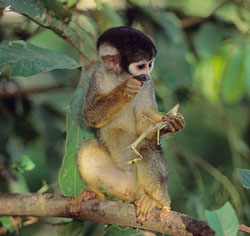There are just five recognized subspecies of Central American squirrel monkey, and they all reside in southern Costa Rica and northern Panama. The smallest and most threatened, Saimiri oerstedii oerstedii, resides primarily along the southwestern coast of Costa Rica. Male monkeys are the largest and weigh a maximum of 2 pounds–even fully grown! Most monkeys have reddish-orange bodies and arms, a white chest, and gray or brownish-black shoulders and tails. They have a white fur mask around their eyes and a black head, chin, and mustache. Groups of 20-75 monkeys are most common, and they form egalitarian societies that travel around tropical rainforests, foraging for food. They rarely come down from the trees, instead spending most of their lives among the branches eating fruit and insects. Baby monkeys are born once a year, usually at the end of the dry season.
Conservation efforts have been hampered by the prevalent local belief that squirrel monkeys are not native to Costa Rica: many people believe they should not receive the protections afforded to endemic creatures! Luckily, a recent study did genetic testing on many monkey species and determined the squirrel monkey is, in fact, native to Central America (Cropp and Boinski 2000). This means it receives more legal protection, and the punishment for killing or trapping them is much greater.
The squirrel monkey is currently listed as vulnerable by the IUCN. Prior to 2008, it had been listed as endangered for almost 20 years. No immediate reason was given for the downgrade in protection status, but it is good news for the little creatures survival! The monkeys live within 21 different protected areas and national parks within Costa Rica, so although they have a lot of territory available, habitat fragmentation is still a concern. Logging and agriculture have reduced available monkey habitat immensely. In fact, habitat fragmentation and deforestation was the initial justification to categorize them as endangered. Squirrel monkeys do have natural predators like eagles and jaguars, but humans are the greatest threat to their survival. Hopefully, with recent conservation efforts, the population will continue to grow back to historical levels.
IUCN
University of California, Berkeley CalPhotos Photo Database
Wisconsin Primate Factsheets
Sources Cited
Cropp, S., and S. Boinski. 2000. The Central American Squirrel Monkey (Saimiri oerstedii): Introduced Hybrid or Endemic Species? Molecular Phylogenetics and Evolution 16(3): 350-365.
Image credits to: University of Wisconsin, University of California Berkeley CalPhotos Photo Database, and the International Union for the Conservation of Nature and Natural Resources.





